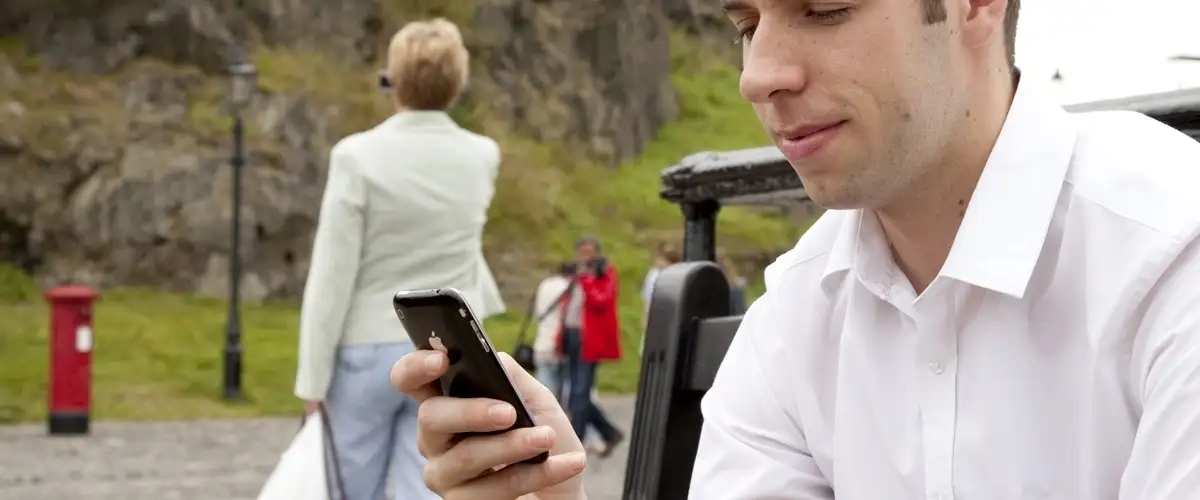
Electronic communication, such as disposable mobile phones, cheap and easy Wi-Fi, and social networking, is revolutionizing the way we travel. But the digital development I am most enthused about is the smartphone. My iPhone has quickly become my favorite travel companion, whether it’s keeping me on top of my work, keeping me in touch with my kids, or simply keeping me entertained.
I’m not alone. It’s predicted that by the end of 2011, half of all American mobile phone users will have a smartphone—iPhone, Android, Windows, or BlackBerry phone—compared to just 10 percent in 2008. And as smartphones get more capable, they are becoming an essential tool for travelers.
For instance, if I’m in a cafe in Paris that has free Wi-Fi, I can pop onto the Internet and check sports scores back home. If an impromptu soccer game breaks out on a piazza in Naples, I can record a video of it, then use the Dropbox application to send it to my assistant, who can post it to my Facebook page. Using Skype on my phone, I can connect to Wi-Fi and call my daughter in the U.S. for free.
About the only thing I don’t use my smartphone for is as an actual cell phone. When roaming in Europe with a U.S. phone, calls are expensive (usually $1.29 a minute, sometimes higher). To save money, I prefer to use a phone I bought years ago in Europe and purchase a new SIM card in each country I visit (a SIM card is a removable chip that stores your information). A phone must be “unlocked” in order to swap out SIM cards (but be aware smartphones can be complicated to unlock). I make a lot of calls when I’m in Europe, but if you don’t, you might find it easier to roam with your own phone.
With smartphones, it’s important to watch data-roaming charges. A three-minute video from YouTube can cost about $40. While doing some casual browsing and emailing costs way less (figure around 20 cents to send or receive a basic message), these charges can pile up quickly.
To avoid these costs, it’s easiest to cut off this feature entirely by calling your carrier to disable it and/or turning off data roaming using your phone’s menu (before you get on your transatlantic flight). You can still use the Internet, but you’ll have to wait until you reach a Wi-Fi hotspot. Otherwise, for the best rates, talk to your carrier about international data-roaming plans.
Even if you don’t use your smartphone for calls or data roaming, it can still come in handy thanks to the many travel-oriented applications that are available. Although I still prefer flipping through a paper guidebook, many publishers also offer travel guides in ebook format. Apps for TripAdvisor and Yelp give you access to millions of user reviews of restaurants, hotels, and sights. And my Rick Steves Audio Europe app has radio interviews and audio walking tours of Europe’s top sights, such as the Acropolis and Versailles.
If you need to search for flights, hotels, or rental cars, try Orbitz, Priceline, Booking.com, Expedia’s TripAssist, and Travelocity. Skyscanner searches a variety of European budget airlines to find the cheapest connection. TripIt is a clever app that stores all of your trip details in one place. Note that many apps (such as ebooks) work on their own once you download them, but others (such as flight-search apps) need to access content online. You’ll either have to find a Wi-Fi hotspot or spring for data roaming to make them work.
To figure out train schedules, DB Navigator, German Rail’s comprehensive train timetables, includes connections for all of continental Europe. For the UK, try thetrainline. Big cities, such as London and Paris, offer subway apps that save you from having to unfold an unwieldy map on a crowded platform.
If you don’t parlez-vous the local language, download Google Translate, which lets you type or speak foreign words for a translation. You can also say or type a sentence in English to hear a translation or see it written out. With Lonely Planet’s audio phrasebooks, simply press a button to hear the phrase you’re struggling to pronounce.
Other useful travel apps include Measures, which converts various European units (such as metric measurements, clothing sizes, and currency) to American ones; the Weather Channel and AccuWeather, which help you figure out how to dress for the day; and mPassport, city-specific apps that direct you to English-speaking doctors and hospitals, as well as local names for prescription medications.
As more people travel with smartphones, I expect that more creative apps will become available. I admit that I can be something of a tech holdout. But if technology can help people travel smoother and smarter, I’m all for it.
Rick Steves (www.ricksteves.com) writes European travel guidebooks and hosts travel shows on public television and public radio. Email him at [email protected] and follow his blog on Facebook.
We hand-pick everything we recommend and select items through testing and reviews. Some products are sent to us free of charge with no incentive to offer a favorable review. We offer our unbiased opinions and do not accept compensation to review products. All items are in stock and prices are accurate at the time of publication. If you buy something through our links, we may earn a commission.
Top Fares From
Today's Top Travel Deals
Brought to you by ShermansTravel
Kenya: 14-Night Tour, Incl. Tanzania &...
smarTours
 vacation
$7125+
vacation
$7125+
7-Night Caribbean Round-Trip Cruise From Orlando:...
Norwegian Cruise Line
 cruise
$739+
cruise
$739+
Ohio: Daily Car Rentals from Cincinnati
85OFF.com
 Car Rental
$19+
Car Rental
$19+



